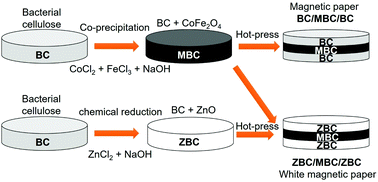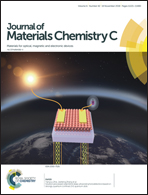White magnetic paper based on a bacterial cellulose nanocomposite
Abstract
A newly proposed idea for the fabrication of white magnetic paper is presented. These papers are fabricated from a layered composite of bacterial cellulose (BC) sheets. Magnetic BC sheets are prepared by the incorporation of CoFe2O4 nanoparticles (NPs) in the BC structure (MBC). White BC sheets were formed by the impregnation of ZnO NPs in the BC nanofibrils (ZBC), and then forming a ZBC/MBC/ZBC sandwich structure. This structure was then hot-pressed to obtain white magnetic paper. The fabricated magnetic BC paper exhibits a ‘whiteness’ of over 80%, with a high reflectance of over 70% in the visible spectral range. XRD and SEM analysis confirmed the presence of the BC, CoFe2O4 and ZnO phases in the white magnetic paper. The whiteness of the paper is improved further with a higher concentration of ZnO NPs, but at the cost of a reduction in the mechanical properties. Magnetic hysteresis was observed in the fabricated white magnetic paper with a saturation magnetization of ∼20 emu g−1, comparable to the literature values for black magnetic papers. The white magnetic paper was demonstrated to exhibit flexibility and foldability just like regular paper sheets but can also be distinguished by subjecting it to an external magnetic field. This gives potential for its use as security paper or in anti-counterfeiting applications.



 Please wait while we load your content...
Please wait while we load your content...